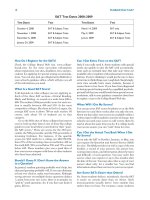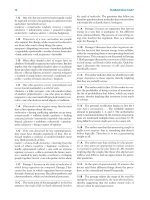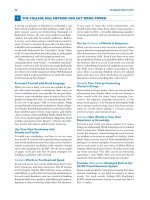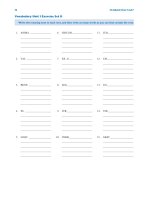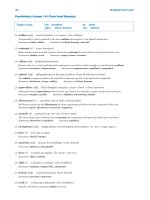Sat - MC Grawhill part 44 pot
Bạn đang xem bản rút gọn của tài liệu. Xem và tải ngay bản đầy đủ của tài liệu tại đây (275.87 KB, 10 trang )
420 McGRAW-HILL’S SAT
2. C The function h(x) is equivalent to the function
g(x) after it has been reflected over the x-axis, ver-
tically stretched by a factor of 3, and shifted down-
ward one unit. After these transformations, the
vertex of the parabola will be at (1, 5), so the
maximum value is y = 5.
3. D Call the original point (a, b). Its reflection over
the line y = x is (b, a). (Draw a graph to see.) The
reflection of this point over the x-axis is (b, Ϫa),
and the reflection of this point over the y-axis is
(Ϫb, Ϫa). If the final point is (3, 4), then the origi-
nal point was (Ϫ4, Ϫ3).
Concept Review 3
1. y = f(x Ϫ 5). Although the Ϫ5 seems to suggest a
shift to the left (because when we subtract 5 from
a number, we move five units to the left on the
number line), this change actually shifts the graph
to the right. To see why, look back at the first two
examples in Lesson 3, and pay particular attention
to how the changed equations produce the individ-
ual points on the graph and how these points com-
pare with the points on the original graph. It also
may help to pick a simple function, such as y = x
2
,
graph it by hand (by choosing values for x, calcu-
lating the corresponding values for y, and plotting
the ordered pairs), and then graph y = (x Ϫ 5)
2
in
the same way to see how the graphs compare.
2. y = Ϫx
2
+ 5. Since the point (x, Ϫy) is the reflection
of (x, y) over the x-axis, reflecting any function
over the x-axis simply means multiplying y by Ϫ1.
This “negates” every term in the function.
3. It is the original graph after it has been “flipped”
vertically and “stretched” vertically. The graph of
y = Ϫ4f(x) is a “vertically stretched” version of
y = f(x) that also has been reflected over the x-axis.
Every point on y = Ϫ4f(x) is four times farther from
the x-axis as its corresponding point on y = f(x) and
is also on the opposite side of the x-axis.
4. Overall shape and maximum and minimum val-
ues. The graph of y = f(x + 15) is simply the graph
of y = f(x) shifted to the left 15 units. It maintains
the shape of the original graph and has the same
maximum and minimum values. (That is, if the
greatest value of y on y = f(x) is 10, then the great-
est value of y on y = f(x + 15) is also 10.)
5. Zeroes, vertical lines of symmetry, and x coordi-
nates of maximum and minimum values. The
graph of y = 6f
(x
) is simply the graph of y = f(x)
that has been “vertically stretched” by a factor of
6. Imagine drawing the graph of y = f(x) on a rub-
ber sheet and then attaching sticks across the top
and bottom of the sheet and pulling the sheet until
it’s six times as tall as it was originally. The
stretched graph looks like y = 6f(x). Although most
of the points move because of this stretch, the
ones on the x-axis do not. These points, called the
zeroes because their y coordinates are 0, remain
the same, as do any vertical lines of symmetry and
the x coordinates of any maximum or minimum
points.
6
. The graph of h(x) = ax
2
+ bx + c, since it is qua-
dratic, looks like a parabola. If a is negative, the
parabola is “open down.” (Remember that y = Ϫx
2
is the graph of the “open up” parabola y = x
2
after
it has been “flipped” over the x-axis.) Also, notice
that c is the “y-intercept” of the graph, since h(0) =
a(0)
2
+ b(0) + c = c. Therefore, the graph is an up-
side-down parabola with a positive y-intercept.
The only choice that qualifies is (B).
7. The point on the d-axis represents the starting
depth of the water. If the tank begins with twice as
much water, the starting point, or “d-intercept,”
must be twice that of the original graph. Also, if
the water drains out at twice the rate, the line
must be twice as steep. Since twice as much water
drains out at twice the rate, the tank should empty
in the same amount of time it took the original
tank to drain. The only graph that depicts this sit-
uation is (A).
Answer Key 3: Transformations
SAT Practice 3
1. D The transformation in (D) is a shift of the orig-
inal function upward two units. This creates a tri-
angular region above the x-axis with a greater
height and base than those of the original graph,
and therefore creates a greater overall area. The
transformation in (A) will create a triangle with
area
1
/
2
A, the transformations in (B) and (C) are
horizontal shifts, and so will not change the area.
The downward shift in (E) will reduce the height
and base, and therefore the total area.
4. A A point and its reflection over a line are both
equidistant to that line. Imagine that point Q has
a y coordinate of 4 (any value between 1 and 6 will
do). This implies that point Q is two units from the
line y = 6, and therefore, point P also must be two
units from the line y = 6 and must have a y coordi-
nate of 8. Point Q also must be three units from
the line y = 1, so point R also must be three units
from the line y = 1 and must have a y coordinate
of Ϫ2. Therefore, the length of PR is 8 Ϫ (Ϫ2) = 10.
CHAPTER 11 / ESSENTIAL ALGEBRA 2 SKILLS 421
5. E You can determine the equation defining the
function through substitution: y = g(f(h(x))) =
g(f(x
2
)) = g(x
2
+ 1)) = Ϫx
2
Ϫ 1, which describes an
“open-down” parabola with vertex at (0, Ϫ1).
Notice that this sequence of transformations takes
the standard parabola y = x
2
and shifts it up one
unit and then reflects the new graph over the
x-axis.
422 McGRAW-HILL’S SAT
Lesson 4:Variation
Direct Variation
The statement “y varies directly as x” means
that the variables are related by the equation
y = kx, where k is a non-zero constant. This
equation implies that x and y go up and down
proportionally. For instance, whenever x is
multiplied by 3, y is also multiplied by 3.
The table and graph above show three examples
of direct variation functions. Notice that (1) every
graph passes through the origin, (2) as k increases, so
does the slope of the graph, and (3) for any given k,
whenever x is doubled (or tripled or halved), so is the
corresponding value of y.
Example:
If x varies directly as y and x = 20 when y = 60,
then what is the value of x when y = 150?
First find the value of the constant k by substituting
the values of x and y into the equation y = kx.
y = kx
Substitute: 60 = k(20)
Divide by 20: 3 = k
Now we know that the equation is y = 3x.
Substitute y = 150: 150 = 3x
Divide by 3: 50 = x
Inverse Variation
The statement “y varies inversely as x” means
that the variables are related by the equations
y = or xy = k, where k is a non-zero constant.
These equations imply that x and y go up and
down inversely. For instance, whenever x is
multiplied by 3, y is divided by 3.
The table and graph above show an example of an
inverse variation function. Notice that (1) the graph
never touches the x-or y-axis, (2) as x increases, y de-
creases, and (3) for every point on the graph, the
product of x and y is always the constant k, in this
case k = 1.
Example:
If x varies inversely as y and x = 40 when y = 10,
then what is the value of x when y = 25?
First find the value of the constant k by substituting
the values of x and y into the equation xy = k.
xy = k
Substitute: (40)(10) = k
Simplify: 400 = k
Now we know that the equation is xy = 400.
Substitute y = 25: x(25) = 400
Divide by 25: x = 16
Joint and Power Variation
A variable can vary with more than one other
variable or with powers of a variable. For in-
stance, the statement “y varies directly as x
and inversely as w” means that and “y
varies inversely as the square of x” means that
.
y
k
x
=
2
y
kx
w
= ,
k
x
CHAPTER 11 / ESSENTIAL ALGEBRA 2 SKILLS 423
Concept Review 4:Variation
1. What equation is equivalent to the statement y varies directly as the square of x?
2. If y varies inversely as x, then the ________________ of x and y is a constant.
3. If y varies directly as x, then the ________________ of x and y is a constant.
4. Describe the features of the graph of a direct variation function.
5. If w varies directly as v
3
and w = 16 when v = 2 , what is the value of w when v = 3?
6. If y varies inversely as the square of x, then what will be the effect on y if the value of x is doubled?
7. The variable a varies inversely as b. If b = 0.5 when a = 32, then for how many ordered pairs (a , b) are both
a and b positive integers
?
8. If x varies directly as the square root of y and directly as z, and if x = 16 when y = 64 and z = 2, what is the
value of z when y = 36 and x = 60?
424 McGRAW-HILL’S SAT
SAT Practice 4:Variation
1. If p varies inversely as q and p = 4 when q = 6,
then which of the following represents another
possible solution for p and q?
(A) p = 8 and q = 12
(B) p = 8 and q = 10
(C) p = 10 and q = 12
(D) p = 12 and q = 1
(E) p = 12 and q = 2
2. Which of the following describes one possible
relationship between the values of m and n
shown in the table above?
(A) n varies directly as m
(B) n varies inversely as m
(C) n varies directly as the square of m
(D) n varies inversely as the square of m
(E) n varies directly as the square root of m
3. If the function f is defined by the equation
f(x, y) = x
2
y
3
and f(a, b) = 10, what is the value
of f(2a, 2b)?
(A) 50
(B) 100
(C) 160
(D) 320
(E) 640
4. At a fixed temperature, the volume of a sample
of gas varies inversely as the pressure of the
gas. If the pressure of a sample of gas at a fixed
temperature is increased by 50%, by what per-
cent is the volume decreased
?
(A) 25%
(B) %
(C) 50%
(D) 75%
(E) 100%
33
1
3
5. The force of gravity between two stars varies in-
versely as the square of the distance between
the stars. If the force of gravity between two
stars that are four light-years apart is 64 ex-
anewtons (1 exanewton = 10
18
newtons), what
would the force between these stars be if they
were eight light-years apart?
(A) 256 exanewtons
(B) 128 exanewtons
(C) 32 exanewtons
(D) 16 exanewtons
(E) 8 exanewtons
6. If the variable a varies directly as b and in-
versely as c, and if a = 10x + 5 when c = 2 and
b = 10, then what is the value of a when b = 4
and c = 2x + 1?
1
2
3
4
5
7
8
9
6
1
0
2
3
4
5
7
8
9
6
1
0
2
3
4
5
7
8
9
6
1
0
2
3
4
5
7
8
9
6
CHAPTER 11 / ESSENTIAL ALGEBRA 2 SKILLS 425
7. If the variable y varies inversely as the square
of x, and if x > 0, then which of the following
operations will double
the value of y?
(A) multiplying x by 2
(B) dividing x by 2
(C) multiplying x by
(D) dividing x by
(E) dividing x by 4
2
2
8. If y = 1 when x = 8 and y = 4 when x = 2, which
of the following could express the relationship
between x and y?
I. y varies inversely as x
II. y varies directly as the square of x
III. y varies directly as x
(A) none
(B) I only
(C) I and II only
(D) I and III only
(E) I, II, and III
426 McGRAW-HILL’S SAT
4. B It’s probably easiest to set up the equation,
then choose simple values for the volume and
pressure, and then “experiment.” Since the vol-
ume varies inversely as the pressure, the product
of the volume and the pressure is a constant: vp = k.
Now choose simple values for v and p, such as 2
and 4: vp = (2)(4) = 8 = k. Therefore, in this case,
the product of the volume and the pressure is
always 8. If the pressure is increased 50%, then
it grows to 1.5(4) = 6. Now solve for the corre-
sponding value of v:
v(6) = 8
Divide by 6:
Therefore, the volume has decreased from 2 to
.
To calculate the percent decrease, use the “percent
change” formula from Chapter 7, Lesson 5:
Percent change =
4
3
2
2
100
2
3
2
100
1
3
100 33
1
3
−
×=
−
×=−×=%%%%
4
3
v =
4
3
Concept Review 4
1. y = kx
2
2. product
3. quotient or ratio
4. It is a straight line passing through the origin with
a slope equal to k, the constant of proportionality.
For every point on the line, the ratio of the y coor-
dinate to the x coordinate is equal to k.
5. Write the general variation equation: w = kv
3
.
Substitute w = 16 and v = 2: (16) = k(2)
3
Simplify: 16 = 8k
Divide by 8: 2 = k
Write the specific variation equation: w = 2v
3
Substitute v = 3: w = 2(3)
3
Simplify: w = 54
6. Write the variation equation: y = k/x
2
or x
2
y = k.
Choose any values for x and y: x
2
y = (1)
2
(3) = 3 = k
Write the specific variation equation: x
2
y = 3
Double the original value of x: (2)
2
y = 3
Simplify: 4y = 3
Solve for y: y = 3/4
So what was the effect on y when you doubled the
value of x? It went from 3 to 3/4, therefore, it was
divided by 4 or multiplied by 1/4.
7. If a varies inversely as b, then ab = k, where k is a
constant. If b = 0.5 when a = 32, then
k = (0.5)(32) = 16. Therefore, in any ordered pair
solution (a, b), the product of a and b must be 16.
The only solutions in which a and b are both pos-
itive integers are (1, 16), (2, 8), (4, 4), (8, 2), and
(16, 1), for a total of five ordered pairs.
8. If x varies directly as the square root of y and
directly as z , then . First, substitute the
values x = 16, y = 64, and z = 2 to find k:
Simplify: 16 = 16k
Divide by 16: 1 = k
Substitute y = 36 and x = 60:
Simplify: 60 = 6z
Divide by 6: 10 = z
60 1 36= z
16 2 64= k()( )
xkzy=
Answer Key 4:Variation
SAT Practice 4
1. E Recall from the lesson that whenever two vari-
ables vary inversely, they have a constant product.
The product of 4 and 6 is 24, so every other correct
solution for p and q must have a product of 24
also. Choice (E) is the only one that gives values
that have a product of 24.
2. D It helps first to notice from the table that as m
increases, n decreases, so any variation relation-
ship must be an inverse variation. Therefore, only
choices (B) and (D) are possibilities. If n varied in-
versely as m, then the two variables would always
have the same product, but this is not the case:
1 ϫ 4 = 4, 2 ϫ 1 = 2, and 4 ϫ .25 = 1. However, if n
varied inversely as the square of m, then n and m
2
would always have the same product. This is true:
1
2
ϫ 4 = 4, 2
2
ϫ 1 = 4, and 4
2
ϫ .25 = 4. Therefore,
the correct answer is (D).
3. D You are given that f(a, b) = a
2
b
3
= 10. Using the
definition, f(2a, 2b) = (2a)
2
(2b)
3
= (4a
2
)(8b
3
)
= 32a
2
b
3
. Substituting a
2
b
3
= 10, you get 32a
2
b
3
= 32(10) = 320.
CHAPTER 11 / ESSENTIAL ALGEBRA 2 SKILLS 427
5. D If the force varies inversely as the square of
the distance, then the product of the force and
the square of the distance is a constant. For these
particular stars, the force times the square of the
distance is (4)
2
(64) = 1024. If they were eight
light-years apart, then the force would satisfy the
equation (8)
2
(f) = 1024, so f = 16.
6. 4 Set up the variation equation:
a = kb/c
Substitute: 10x + 5 = k(10)/2
Simplify: 10x + 5 = 5k
Divide by 5: 2x + 1 = k
Substitute new values: a = (2x + 1)(4)/(2x + 1)
Simplify: a = 4
7. D If y varies inversely as the square of x, then
their product x
2
y is a constant. To keep it simple,
pick x and y to be 1, so the product (1)
2
(1) = 1. To
find the value of x that would double y, simply
double y and solve for x.
If x
2
(2) = 1, then . This is the original
value of x divided by .
8. B Since y increases as x decreases, any variation
must be an inverse variation. Since the product of
x and y is a constant (1 ϫ 8 = 4 ϫ 2 = 8), y varies
inversely as x.
2
x =12
428 McGRAW-HILL’S SAT
Lesson 5: Data Analysis
Scatterplots and Lines of Best Fit
A scatterplot is a collection of points plotted on a
graph that is used to visualize the relationship be-
tween two variables. A line of best fit is a straight line
that best “hugs” the data of a scatterplot. This line
usually divides the points roughly in half. This line
can be used to make predictions about how one of
the variables will change when the other is changed.
The SAT may ask you to describe the basic
features of a line of best fit for a set of data, but
it won’t ask you to find this equation exactly.
You can usually just eyeball it: draw a line that
fits the data and cuts the points roughly in
half, and then notice whether the slope of the
line is positive, negative, or 0, and then notice
roughly where its y-intercept is.
Example:
If the Smiths own as many pieces of electronic
equipment as the Carsons do, how many cell
phones do the Smiths own?
Start with the first table. The Carsons own 3 + 4 +
2 = 9 pieces of equipment. If the Smiths own the same
number of pieces, they must own 9 Ϫ 4 = 5 tele-
phones. Now go to the “Telephones” table. Since the
Smiths have five telephones and two are not cell
phones, they must own 5 Ϫ 2 = 3 cell phones.
As with tables, always carefully read the labels
of pie charts to understand what the data rep-
resent before tackling the question. In a pie
chart, a sector containing x% of the data has a
central angle of (x/100)(360°).
Example:
In the pie chart above, what is the angle measure
of the sector represented by the color purple?
Purple accounts for 20% of the circle, and 20%
of 360° = (0.2)(360°) = 72°.
Example:
What is the approximate slope of the line of best
fit in the scatterplot above?
To estimate the slope of a line of best fit, pick two
points on your line of best fit and use the slope equation
(from Chapter 10, Lesson 4) to solve for m. It appears
that the line of best fit connects the points (30, 40)
and (90, 90), so .
Tables, Charts, and Graphs
A table is a set of data arranged in rows and
columns. If an SAT question includes a table, al-
ways read the table carefully first, paying special
attention to the axis labels, and try to understand
what the table represents before tackling the
question. If you are given two tables, make sure
you understand how the two tables are related.
m =
−
−
==
90 40
90 30
50
60
5
6
CHAPTER 11 / ESSENTIAL ALGEBRA 2 SKILLS 429
Concept Review 5: Data Analysis
1. What is a line of best fit?
2. How is a line of best fit created?
3. How do you estimate the slope of a best fit line?
4. When given percentages in a pie chart, how do you determine how many degrees each sector represents?
Questions 5 and 6 refer to the bar graph at right:
5. The largest percent increase in number of accidents occurred between
which two days of the week?
6. Approximately what percentage of the accidents occurred on Friday,
Saturday, or Sunday?
Questions 7–9 refer to the pie chart at right:
7. The pie chart shows the results of a survey that asked 4,000 kindergarten
students their favorite color. How many more students said yellow was
their favorite color than said blue was their favorite color?
8. What is the degree measure of the sector of the circle that represents red?
9. Using the data in the pie chart, how many students would have to change
their answer to blue in order for blue to account for 50% of the data?
Questions 10–11 refer to the tables at right:
10. According to the tables, which school ordered the most
amusement park tickets?
11. If all the students who went to Coaster Heaven from New
Haven Public and Hamden High bought 5-day passes, how
much more money did Hamden High spend than New
Haven Public did at Coaster Heaven?
5
10
15
Car Accidents
(in thousands)
Sundays
Mondays
Tuesdays
Wednesdays
Thursdays
Fridays
Saturdays
HIGHWAY ACCIDENT
FREQUENCY 2003


